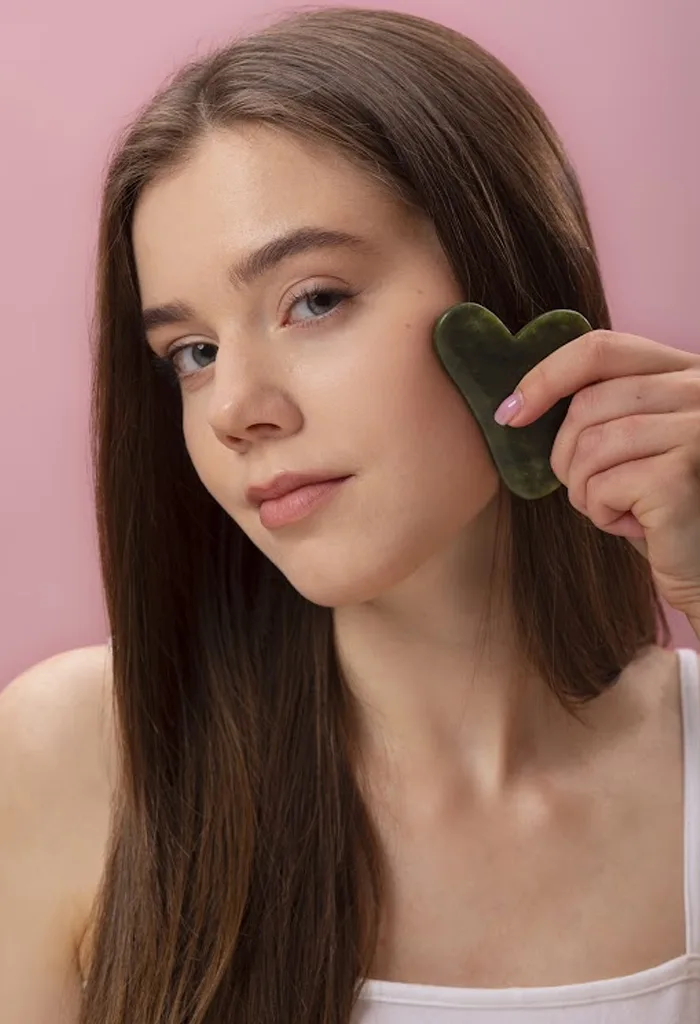In the era of Instagram’s thriving beauty community, one hashtag has been captivating the attention of skincare enthusiasts worldwide – #GuaSha. This trending feed showcases faces that appear smooth, pore-less, and impeccably contoured. Notably, the mysterious art of “How to Gua Sha” has inundated TikTok and various social media platforms, introducing a new perspective on this ancient practice. Gone are the days of clunky spoons and knuckles; today’s Gua Sha has evolved into a refined and luxurious experience, featuring elegant devices, facial rollers, and flat, grooved tools crafted from precious stones like jade and rose quartz.
My introduction to Gua Sha was far from a soothing, meditative experience. Childhood summers in my aunt’s sweltering Shanghai apartment exposed me to an unorthodox version of Gua Sha. To assess my health and combat the oppressive heat, my aunt would use a spoon or her knuckles to create reddish-purple marks on my skin. She claimed this practice would draw out toxins causing my discomfort. All I recall is the discomfort and embarrassment of the resulting welts that resembled misplaced hickeys.
So, how did this ancient remedy transform into a self-care ritual for skincare enthusiasts? To unravel the mysteries of Gua Sha and discover its true benefits, I sought insights from the experts, offering you a Gua Sha 101 crash course.
The Origins of Gua Sha
Contrary to the lore that Gua Sha was a cherished beauty routine of ancient Chinese princesses, the truth is quite different. Ping Zhang, a traditional Chinese medicine expert, explains that Gua Sha originally served practical purposes, such as relieving heatstroke or addressing seasonal illnesses. It was a technique used to revive farmers exhausted by toil under the scorching sun, and it could be performed with various tools, from animal bones and soup spoons to coins. Over the centuries, Gua Sha evolved into a healing practice used across Asia to release muscle tension, improve circulation, and promote the body’s natural healing processes.
Jeremy Lin, a traditional Chinese medicine practitioner, elaborates on the technique, describing how it involves scraping the skin with a smooth-edged instrument, resulting in the appearance of red spots known as “sha” on the skin’s surface. Gua Sha, he explains, has been integral to traditional Chinese medicine for centuries and continues to be practiced in various Asian cultures, with differences in tools and techniques.
The Gua Sha Benefits
The facial benefits of Gua Sha were discovered serendipitously. As acupuncturists utilized facial pressure points to address issues elsewhere in the body, they observed that wrinkles were vanishing. This revelation led to the development of techniques like the Gua Sha Facial Fusion protocol, which employs flat S-shaped nephrite jade stones to stimulate lymph drainage, reduce puffiness, and kickstart the body’s natural cleansing system.
In the fashion world, gua sha facials have gained popularity as well. Acupuncturist Elaine Huntzinger’s Paris-based atelier offers highly sought-after gua sha facials, resulting in notable transformations. Gua Sha is not just a skin-deep treatment; it aims to balance the body, mind, and spirit, addressing emotional imbalances through the lens of Chinese medicine.
Additional benefits of Gua Sha include reduced anxiety, relief from pain, improved blood circulation, and relaxation when performed correctly. However, the downsides of Gua Sha must not be underestimated. When done incorrectly, there is a risk of bruising, discoloration, or severe muscle soreness. It is not recommended for individuals on blood thinners or those with thin skin, and caution should be exercised by pregnant individuals or those with skin conditions. If you’ve had facial injections like Botox or fillers, it’s advisable to wait at least four weeks before attempting Gua Sha.
The Gua Sha Approach
The holistic philosophy of Gua Sha is gaining traction in the beauty industry, focusing on a deeper connection between body and soul. Acupuncturist Beth Griffing Russell underscores the practice’s accessibility and replicability, making it a favored choice over treatments like Botox. Gua Sha enthusiasts are encouraged not to neglect the neck, as it plays a crucial role in stimulating energy flow and contributing to a radiant complexion.
With options ranging from basic, affordable treatments at medical massage clinics to high-end “shamanic” facials, Gua Sha caters to a diverse audience. Although the results may not always be transformative on a surface level, many attest to feeling rejuvenated from the inside out after a Gua Sha session.
A Holistic Conception of Beauty
The popularity of Gua Sha hints at a yearning for a holistic approach to beauty. In a world inundated with external stimuli, it appears that Gua Sha has emerged as a means to restore focus on the yin—the darker, interior, reflective aspects of ourselves. Chinese medicine emphasizes the connection between health and beauty, and Gua Sha embodies this philosophy by promoting “yang sheng” or “nourishing life.”
How to Gua Sha at Home
For those seeking an accessible approach to Gua Sha, traditional Chinese medicine practitioner Michelle Han shares her personal method. It involves applying a light facial oil, selecting a suitable Gua Sha tool, and using gentle strokes to stimulate the skin’s circulation. Smooth and controlled strokes, without excessive pressure, are crucial to avoid bruising and discoloration.
For the best results, Han recommends consulting a TCM practitioner or Gua Sha specialist for a customized treatment plan tailored to your skin’s unique needs. Gua Sha is more than a skin-deep practice when done correctly, offering a profound connection to holistic well-being.
In the world of skincare, Gua Sha is no longer a mystery, but a cherished practice that intertwines the beauty of tradition with the luxury of self-care. Whether you opt for an at-home ritual or indulge in a spa treatment, Gua Sha promises a journey towards nourishing life and enhancing your natural radiance.



